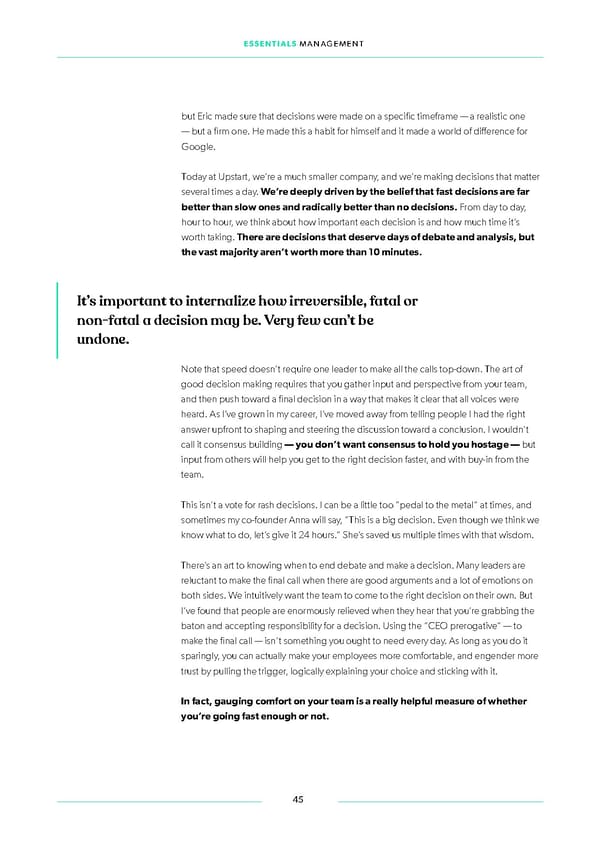ESSENTIALS MANAGEMENT but Eric made sure that decisions were made on a speciifc timeframe — a realistic one — but a ifrm one. He made this a habit for himself and it made a world of difference for Google. Today at Upstart, we’re a much smaller company, and we’re making decisions that matter several times a day. We’re deeply driven by the belief that fast decisions are far better than slow ones and radically better than no decisions. From day to day, hour to hour, we think about how important each decision is and how much time it’s worth taking. There are decisions that deserve days of debate and analysis, but the vast majority aren’t worth more than 10 minutes. It’s important to internalize how irreversible, fatal or non-fatal a decision may be. Very few can’t be undone. Note that speed doesn’t require one leader to make all the calls top-down. The art of good decision making requires that you gather input and perspective from your team, and then push toward a ifnal decision in a way that makes it clear that all voices were heard. As I’ve grown in my career, I’ve moved away from telling people I had the right answer upfront to shaping and steering the discussion toward a conclusion. I wouldn’t call it consensus building — you don’t want consensus to hold you hostage — but input from others will help you get to the right decision faster, and with buy-in from the team. This isn’t a vote for rash decisions. I can be a little too “pedal to the metal” at times, and sometimes my co-founder Anna will say, “This is a big decision. Even though we think we know what to do, let’s give it 24 hours.” She’s saved us multiple times with that wisdom. There’s an art to knowing when to end debate and make a decision. Many leaders are reluctant to make the ifnal call when there are good arguments and a lot of emotions on both sides. We intuitively want the team to come to the right decision on their own. But I’ve found that people are enormously relieved when they hear that you’re grabbing the baton and accepting responsibility for a decision. Using the “CEO prerogative” — to make the ifnal call — isn’t something you ought to need every day. As long as you do it sparingly, you can actually make your employees more comfortable, and engender more trust by pulling the trigger, logically explaining your choice and sticking with it. In fact, gauging comfort on your team is a really helpful measure of whether you’re going fast enough or not. 45
 Essentials Management First Round Capital Page 44 Page 46
Essentials Management First Round Capital Page 44 Page 46